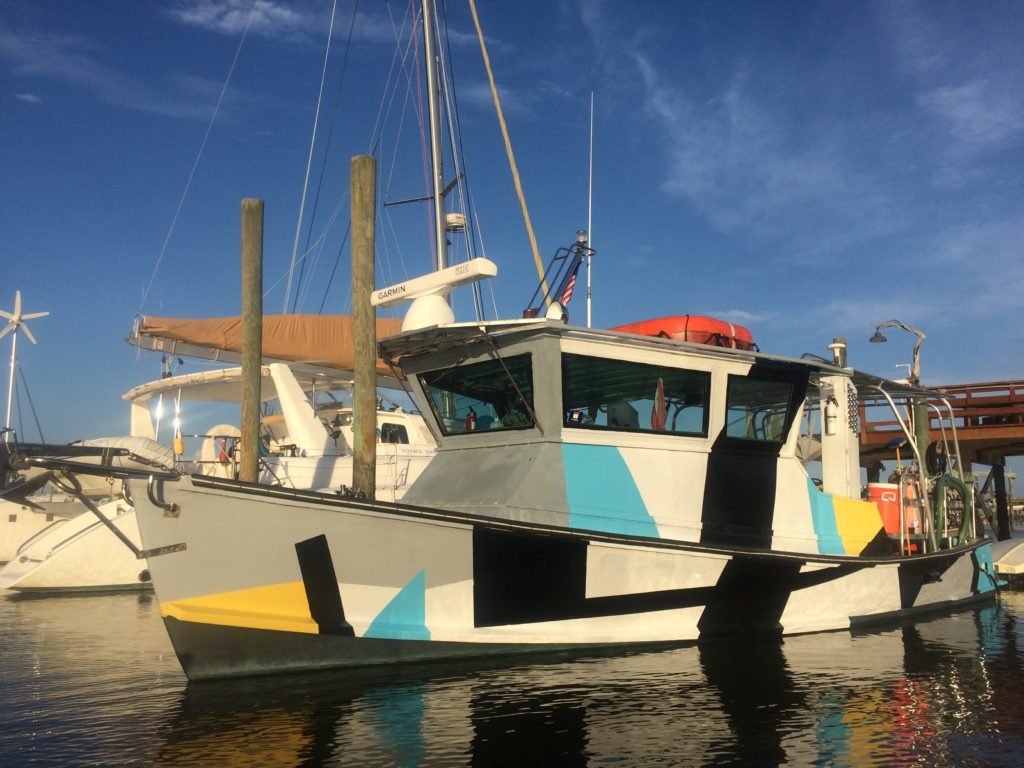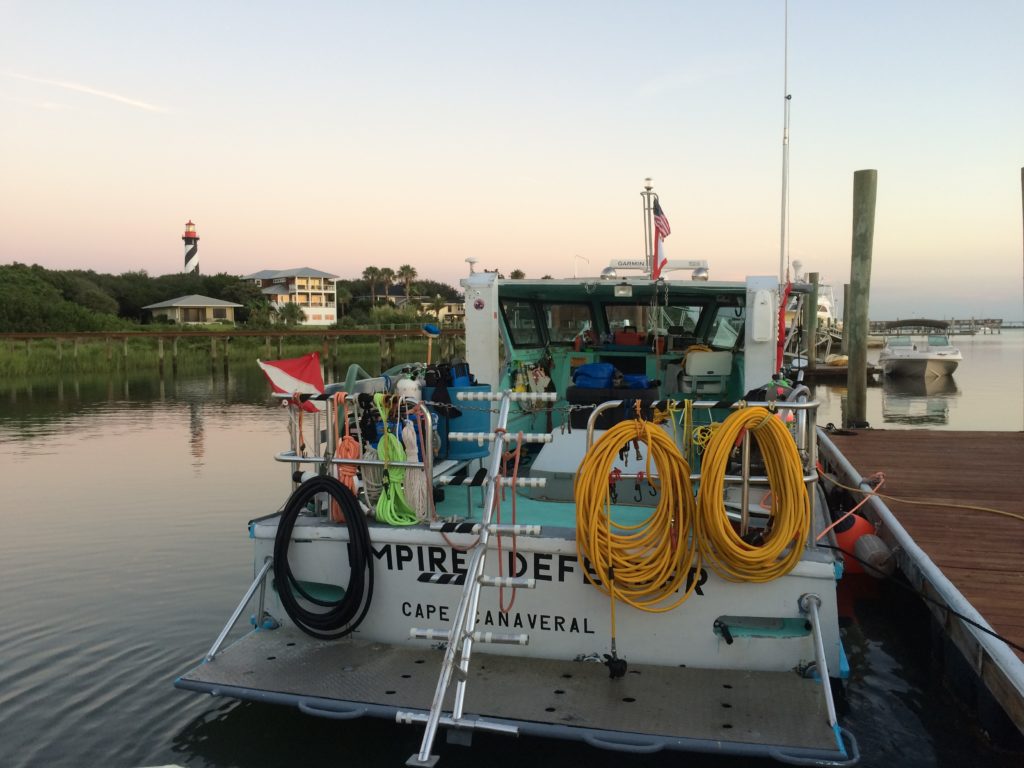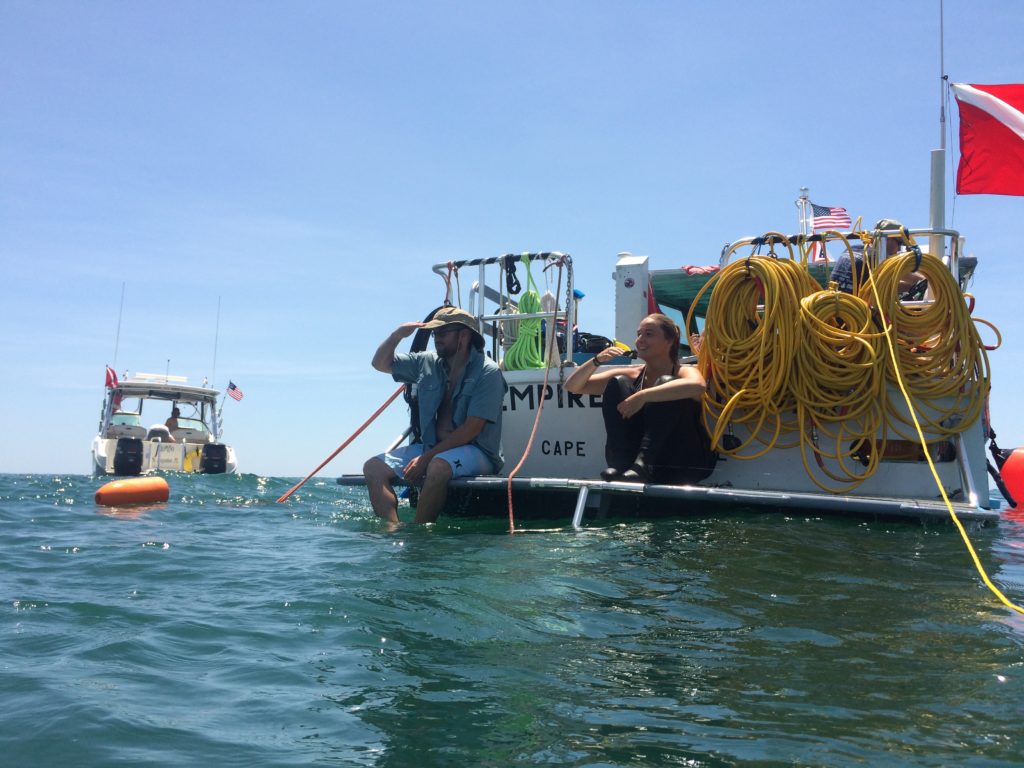This month we focus on two great guys and two great boats that helped us move forward this summer. Mike Potter and Kevin Carrigan are supporters who literally help our research stay afloat. If you haven’t seen us around town, or offshore, here’s the skinny on our boat ops from the summer of 2016.
Each summer, the Lighthouse Archaeological Maritime Program (LAMP), research arm of the St. Augustine Lighthouse & Maritime Museum, heads out to sea for a field season of shipwreck discovery. Our field laboratory floats on the Atlantic Ocean, packed with researchers, volunteer assistants, equipment. Each day it sets out in the soft amber light of a Florida summer sunrise. During this part of the year the St. Augustine inlet settles down into a somnolent state, rarely raising its head in anger. I guess even an inlet needs to take a break from shipwrecking. Only occasionally does a far-flung storm from well over the horizon raise and send us a sea that prohibits work, or sometimes an unseasonal trade wind that dipping into the Atlantic bight runs its invisible hand over the sea to rake up haystacks. But for the most part, our summers are defined by a rhythm of heading to sea at sunrise, mooring on a shipwreck site while the sun is well above the yardarm, and getting underway for home sometime in the late afternoon.
Our laboratory, for the past seven years, has been a steel trawler named Roper. Most of you reading this are familiar with Roper as she has become part of our research family, as much as 17 tons of steel and iron can. But, this year she played only home games, plodding the Potomac River and Chesapeake Bay in the name of science. That left us without a research vessel – a commuter bus, pickup truck, office, wet lab, and dive platform all rolled into one. While Roper had important work to do, stopping fieldwork for lack of a research vessel meant losing more than a decade of momentum, allowing the beating heart of research to pause. As with most near-crises, friends of Museum came to the rescue.
Mike Potter
With water streaming down the outside of the windows and lightning flashing outside, it was a dark and stormy night last November that found LAMP Director Chuck Meide and myself in a pizza joint in Cocoa, Florida. Our friend, Mike Potter convened a dinner to bring like-minded divers together. During the meeting we told Mike that Roper’s dance card was completely full in the Chesapeake for 2016 and that she wouldn’t be available for a Florida cruise. Without hesitation, Mike jumped at the opportunity to fix a problem, he volunteered his own boat. As a boat mechanic, he is used to looking at problem and seeing solutions. Sandra, Mike’s wife, sat by us quietly noting the conversation. She is full partner in their adventures. While she doesn’t dive, Sandra is the ‘sanity on the surface’ and has relentlessly supported Mike’s SCUBA mission, always ready to host out of town divers, never wincing at repair or equipment bills, ever-vigilant when the boat is out. She is Mike’s Mission Control.
A homeboy from Cocoa, Florida, Potter has always immersed himself in the sciences of the Cape, a place where rockets flew to the moon during his boyhood and the area code is still ‘321’. Like many people with a sense of adventure, Mike was called by the sea. Through the 80s and 90s, he grew into the diving community around the Cape and became a leader in new technology that allowed humans to explore deeper into Davy Jones’ locker. The diving club he was part of wasn’t your typical fish and reef folks, dives over 200’ were as common as breathing helium mixtures to prevent decompression sickness. Their dive sites were shipwrecks, scattered around the waters of Florida’s only Atlantic cape.
On a routine 240’ dive one summer, Mike explored the silent remains of Cities Service Empire, a 465’ tanker torpedoed in the Battle of the Atlantic. The twisted steel of the wreck rested at such a depth that artifact looters had yet to work it over. Portholes, ceramics, everything seemed to lie in and on the wreck; the place was almost untouched. Mike and his friends had occasionally brought up artifacts from the wreck as souvenirs, medals for having penetrated the deep and come back alive. During the dive, Mike thought of his father, who served in the Naval Armed Guard during WWII when Empire was sunk. He thought of the fifteen men who lost their lives in a burning sea, a backwater of the war that Nicholas Monserrat described as
“a private war. If you were in it, you knew all about it. You knew how to keep watch on filthy nights, and how to go without sleep, how to bury the dead, and how to die without wasting anyone’s time.”
Mike knew that a twist of fate could have put his father on this ship and ranked him among the perished. The wreckage Mike and his friends were diving became grail to this quiet battle, a dark and cerulean crypt patrolled eternally by barracuda. Beginning his ascent to the surface, Mike was a diver reborn -a defender of the Empire – and a man who takes shipwreck protection as seriously as his faith. Today Mike has led efforts to protect the wreck from disturbance and cautions any diver to “have reverence when you go there. If you don’t have the respect and the reverence, stay home.”

Dockside, Empire Defender shows off her sharp entry. The 31’ dive boat has served as LAMP’s primary research platform for the 2016 field season.
Empire Defender – A lot of story.
Freetime was built in 1978 by Stuart Angler as part of 10 commercial hulls marketed to snapper fishermen and charter outfits. Based on a northeastern-style lobster boat, she was built with a round but shallow bottom and a very fine entry. For years, Freetime explored the waters of Key Largo as one of Dive World’s fleet of charter boats. Her owner, Capt. Corky, was instrumental in bringing the ex-Coast Guard cutters Bibb and Duane to the Keys. Sometime in the late 90s Freetime ended up in Tarpon Springs where she went un-loved and ended up sinking in a marina.
Mike spotted Freetime in her poor state but recognized her potential. He paid the yard to pump her up, haul her out, and had her trucked to his shop in Cocoa. She was stripped of her old rotten plywood house and taken down to a bare fiberglass hull. In 2004, after a four-year rebuild and major renovation, and after Mike’s epiphanic dive on Cities Service Empire, the boat was repainted and renamed. Empire Defender. Her new color scheme was unmistakable – dazzle camouflage – a pattern devised during the First World War to confuse U-boats captains computing a torpedo solution. Unrestricted submarine warfare included merchantmen and so tankers and bulk-carriers, the plodding mules of the sea, took on garish appearances to trick the enemy’s eye. Now too, Empire Defender carries the stripes of conflict, a conflict that included division amongst Mike’s diving community.
Within the close-knit cadre of dedicated divers at Cape Canaveral, Mike worked to promote wreck protection. Not everyone agreed. Many divers continued to view wrecks as a resource to be plundered for mantelpiece trophies. Bullheaded and determined to stop the wholesale looting of wrecks, Mike went to battle. One such skirmish had Mike 200’ below the ocean’s surface, cutting-away an air lift bag. Rigged to haul heavy object up using a balloon of air, the bag had been attached to one of Cities Service Empire’s engine order telegraphs. Large bronze icons of the old steamship bridge it would make a fine living room addition, or a few thousand bucks at an antique store. But it was part of a war grave and carried the same sanctity as a tombstone. Mike took action and the telegraph is still bolted to Cities Service Empire’s bridge wing. Today, there’s a look of hardened resolve in his eye when telling the story, always finishing with a wide eyed look of challenge to the audience as if to say ‘you may not believe me but I was there, putting it all on the line to keep that wreck safe.’ It’s a challenge worth taking.
Mike Potter is a gentle soul who works through problems, not butting through. The old days of fast living are over and it’s common for him to say how much he enjoys seeing fish as companions when diving, rather than meals to be speared or hooked. He has seen what unregulated taking of artifacts and fish has done to his old Florida, a place mostly relegated to memory. Diving has taken Mike places, from spiritual balance to healing of the body, from his own backyard pool to benthic deeps full of mystery where danger lurks in every shadow. Along the journey Mike has become a defender too, pushing for people to explore but protect, to learn be leave-be. His commitment to our mission has been unwavering and this year in Roper’s absence Empire Defender stood in to save the day.
In mid-June, friend and museum volunteer Josh Dotson and I travelled to Cape Canaveral to deliver Empire Defender north. After a day of maintenance and prepping, we made the trip up to St. Augustine via the ‘inside’, or the Intracoastal Waterway. Too rough to bring the boat up the coast, we motored through the Canaveral Locks, crossed Banana River lagoon, passed up Indian River and into Mosquito Lagoon, slow-steamed by the unassuming waterfront of Edgewater, snuck under the towering chaos of Daytona Beach, threaded our way through the narrows ditch past Palm Coast, and passed under the sodium-vapor glow of the Bridge of Lions in St. Augustine about half-past midnight. The only excitement was when a bolt came loose, allowing the rudder to swing free. Helpless without any steerage, we dropped the anchor and broke out the tools. After 10 minutes, we found and a re-tightened the loose bolt and were back underway on the night watch. Cruising in the dark of night, Josh and I both concluded that we prefer boring boat trips.

Taken just before getting underway, Empire Defender show off her tools for diving. Yellow hoses supply air to divers, blue ones supply water. The pumps keep the hoses full, and the black hoses is for probing new shipwreck targets. A big part of offshore work is managing lines and hoses.
Once berthed in St. Augustine, Empire Defender went to work. Twelve students from around the country matriculated into the 2016 LAMP Field School, a program celebrating its 10th anniversary this year. As primary support platform, Empire Defender was outfitted with two water pumps to power induction dredges on the sea floor, a breathing-air pump, and enough tanks, hoses, and gear to commit archaeology underwater. Since she was built as a dive boat, her fittings are stout, not the sort of pretty but weak deck gear found on recreational boats. Beneath her deck are five watertight compartments, each with its own high-capacity bilge pump and a secondary manual pump. In the central compartment lives her powerplant, a Caterpillar 3126 we named ‘Beatrix’ this summer. At 2200 rpm it generates a touch under 200hp which pushes the boat at 12-13kts. Her fuel tank holds enough juice for 16 hours of cruising, and her racks are built to carry at least 28 SCUBA tanks. Custom built, the bow has a very sharp entry built to slice rather than butt. When heading out a lively inlet, she swims through the tops of waves like a dolphin. Empire Defender is as unique as her livery, unmistakable and unforgettable.
Kevin Carrigan
A native to Chicago, Kevin travelled all over the world, 90 countries to be sure! He has a degree in Marketing and Business Administration from Notre Dame, and also studied at University College Dublin and the Gaiety School of Acting, located in the heart of Dublin. From there, Kevin worked his way up through the film business in Northern Ireland and NYC, producing, shooting and editing documentaries for PBS and National Geographic Channels International. While keeping his toe in the film industry and living on his sailboat, Kevin went to work laying deep-sea fiber optic cables. As a pilot/tech, operating the largest working class ROV’s in the world at crushing depths, Kevin helped to connect SE Asia to Western Europe via fiber optics, mostly in the Malacca Straights. He has also worked on the transatlantic cable, the Caribbean network and a Navy crash investigation off Norfolk. A story he tells from those days was pushing an ROV well beyond its operational limits to finish a job in Bangladesh way ahead of schedule and under budget. That same sort of spirit is exactly who we are looking for at LAMP and Kevin fit in perfectly.

Kevin Carrigan with his wife, Mary, on one of their expeditions to South Florida. I meant the South Pole! Photo courtesy of Kevin Carrigan.
Having moved to St. Augustine from Costa Rica in 2015 Kevin and his wife Mary were looking to explore the charm and history of the Ancient City. One of Kevin’s first moves was to buy a boat, arguably the best way to explore our local scenery and history. No stranger to boating, Kevin has sailed over 16,000 miles of the world’s oceans while living on his sailboat. He has been diving since he was 11 years old, and getting his feet wet again was first on the agenda and working with the Lighthouse just seemed like a good way to do it.
Kevin was on hand as support captain with his boat for every day of the 2016 LAMP Field School and continues as a LAMP diver and part of the research team. He has recently been certified with AAUS Scientific Diver-equivalency and as a DAN Oxygen Administrator. His help, generosity, and enthusiasm are instrumental to bring needed capacity and personnel to our excavations. We are proud to count him in our number!
Mombo – One mission, two hulls.
Capt. Carrigan’s chariot can aptly be described as just that, a chariot. The boat is a World Cat 29, a catamaran-style fishing boat renowned for their seaworthiness and quality of build. Since the boat has two hulls and 500hp pushing them, she had no problem getting out of the hole and cruising along pretty quick (something that few LAMP field school participants have experienced!). She can also take the inlet well and lies at anchor smoothly given her wide stance across the waves.
The name Mombo comes from Kevin’s mom Mary, but known only as ‘Mombo’ to her four sons and daughter. According to the family, her four boys tested Mrs. Carrigan’s patience as well as the laws of physics, a test she endured well. In 2014, Mary passed away after a battle with cancer and less than two years later, her name lives on in a way that the family enjoys and students can benefit from. Kevin has graciously offered the use of Mombo as LAMP need to periodically monitor and search for shipwrecks in the St. Augustine area.
To both these generous fellows we say THANK YOU!! Glad to have you on board and look forward to many more years sailing and discovering together.
Brendan Burke joined the St. Augustine Lighthouse & Maritime Museum in 2007 as an archaeologist for the Lighthouse Archaeological Maritime Program. He holds a graduate degree in Anthropology from the College of William & Mary.




